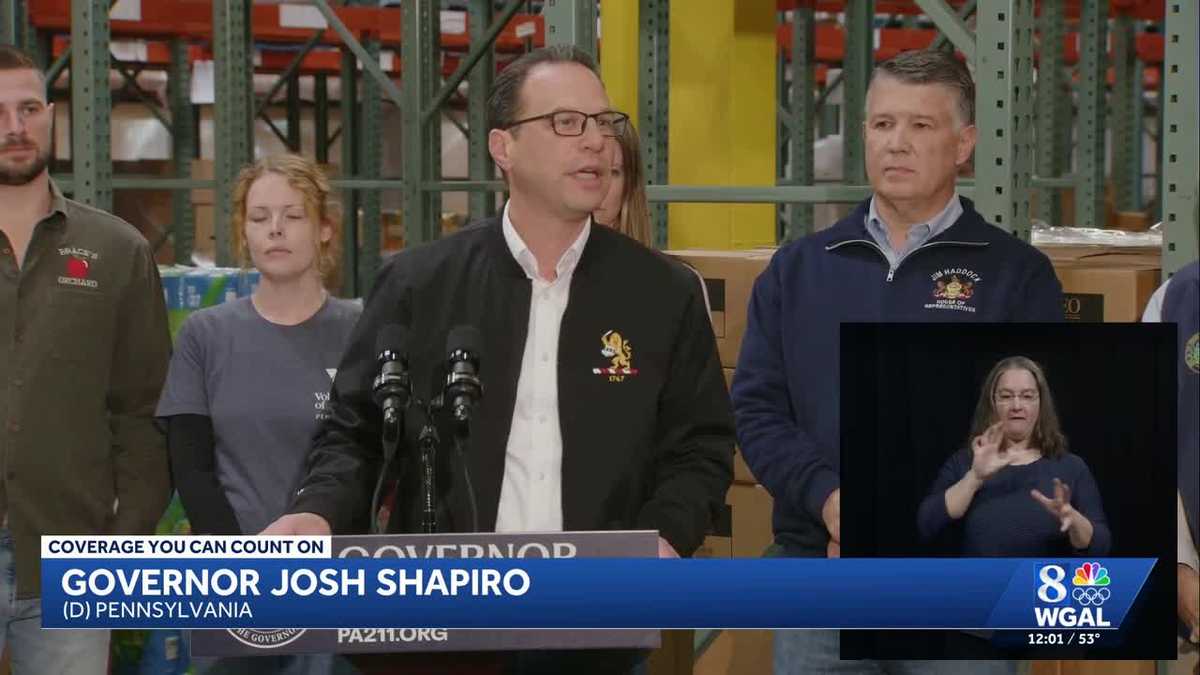I’M RACHEL HIRSCHHEIMER. GOVERNOR JOSH SHAPIRO IS IN LUZERNE COUNTY TODAY TALKING ABOUT WHAT THE STATE IS DOING TO BOOST THE SNAP EMERGENCY RELIEF FUND, HELPING PEOPLE IN NEED DURING THE SNAP UNCERTAINTY BECAUSE OF THE GOVERNMENT SHUTDOWN. SHAPIRO SPOKE AT THE WAYNESBURG NORTHEAST REGIONAL FOOD BANK IN PITTSTON. HERE IN PENNSYLVANIA, I WANT YOU TO UNDERSTAND THE NEED 2 MILLION PENNSYLVANIANS RELY ON SNAP. OUR ENTIRE POPULATION IN THIS COMMONWEALTH IS 13 MILLION PEOPLE. THAT MEANS 1 IN 8 OF OUR NEIGHBORS RELIES ON SNAP. SHAPIRO SAYS THA
$366 million spent every month on Pa. SNAP benefits, food banks can’t meet need, Shapiro says

Updated: 1:18 PM EST Nov 6, 2025
Pennsylvania Gov. Josh Shapiro visited Luzerne County on Thursday to address state efforts to enhance SNAP emergency relief funds amid ongoing uncertainty.Shapiro spoke to the media at the Weinberg Northeast Regional Food Bank in Pittston to discuss the state’s efforts to boost the SNAP emergency relief fund and support those in need during the SNAP uncertainty.”Here in Pennsylvania, I want you to understand the need. Two million Pennsylvanians rely on SNAP. Our entire population in the commonwealth is 13 million. That means one in eight of our neighbors relies on SNAP,” Shapiro said.Shapiro said that number includes 714,000 children.Last week, the governor signed a disaster declaration that made $5 million in state money immediately available to food banks.$366 million a monthShapiro credited food banks for stepping up to help, but said it’s not enough. “Our Pennsylvania food banks, despite doing the Lord’s work, they cannot meet the need that is left with SNAP not being funded. Understand that we spend $366 million of federal money on those 2 million Pennsylvanians each and every month. And so, while it’s important what we’re doing here at the food banks, it can’t make up for what’s happening as a result of SNAP not being funded.”Leaders in the private sector are matching dollars that the Shapiro administration is putting into food banks. Over the past several days, $2 million in private funds have been raised to match the state funds, according to the governor.SNAP by the numbersThese county-by-county statistics are from the Pennsylvania Department of Human Services.Adams County: 8,827 people, 8% of the population.Cumberland County: 26,448 people, 10% of the population.Dauphin County: 51,744 people, 18% of the population.Franklin County: 19,168 people, 12% of the population.Juniata County: 2,568 people, 11% of the population.Lancaster County: 55,131 people, 10% of the population.Lebanon County: 18,427 people, 13% of the population.Mifflin County: 7,585 people, 16% of the population.Perry County: 4,827 people, 11% of the population.York County: 59,500 people, 13% of the population.Nearly 2 million people across the commonwealth get SNAP.DonationsWGAL is partnering with the Central Pennsylvania Food Bank to help those struggling to keep food on the table without SNAP support.Starting Monday, we will host a weeklong “Hunger Can’t Wait” online donation drive.Every dollar you give provides four meals.Every dollar stays in the Susquehanna Valley.MAKE A DONATION | If you can help, visit this Central Pennsylvania Food Bank page and donate.If you can help, please give — because hunger can’t wait.The need across the Susquehanna Valley is great, where more than a quarter of a million people receive SNAP benefits.
PITTSTON, Pa. —
Pennsylvania Gov. Josh Shapiro visited Luzerne County on Thursday to address state efforts to enhance SNAP emergency relief funds amid ongoing uncertainty.
Shapiro spoke to the media at the Weinberg Northeast Regional Food Bank in Pittston to discuss the state’s efforts to boost the SNAP emergency relief fund and support those in need during the SNAP uncertainty.
“Here in Pennsylvania, I want you to understand the need. Two million Pennsylvanians rely on SNAP. Our entire population in the commonwealth is 13 million. That means one in eight of our neighbors relies on SNAP,” Shapiro said.
Shapiro said that number includes 714,000 children.
Last week, the governor signed a disaster declaration that made $5 million in state money immediately available to food banks.
$366 million a month
Shapiro credited food banks for stepping up to help, but said it’s not enough.
“Our Pennsylvania food banks, despite doing the Lord’s work, they cannot meet the need that is left with SNAP not being funded. Understand that we spend $366 million of federal money on those 2 million Pennsylvanians each and every month. And so, while it’s important what we’re doing here at the food banks, it can’t make up for what’s happening as a result of SNAP not being funded.”
Leaders in the private sector are matching dollars that the Shapiro administration is putting into food banks. Over the past several days, $2 million in private funds have been raised to match the state funds, according to the governor.
SNAP by the numbers
These county-by-county statistics are from the Pennsylvania Department of Human Services.
Adams County: 8,827 people, 8% of the population.Cumberland County: 26,448 people, 10% of the population.Dauphin County: 51,744 people, 18% of the population.Franklin County: 19,168 people, 12% of the population.Juniata County: 2,568 people, 11% of the population.Lancaster County: 55,131 people, 10% of the population.Lebanon County: 18,427 people, 13% of the population.Mifflin County: 7,585 people, 16% of the population.Perry County: 4,827 people, 11% of the population.York County: 59,500 people, 13% of the population.
Nearly 2 million people across the commonwealth get SNAP.
Donations
WGAL is partnering with the Central Pennsylvania Food Bank to help those struggling to keep food on the table without SNAP support.
Starting Monday, we will host a weeklong “Hunger Can’t Wait” online donation drive.
Every dollar you give provides four meals.Every dollar stays in the Susquehanna Valley.
MAKE A DONATION | If you can help, visit this Central Pennsylvania Food Bank page and donate.
If you can help, please give — because hunger can’t wait.
The need across the Susquehanna Valley is great, where more than a quarter of a million people receive SNAP benefits.

